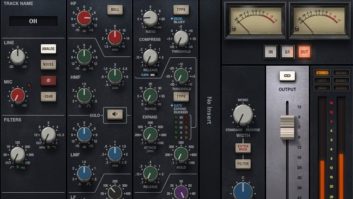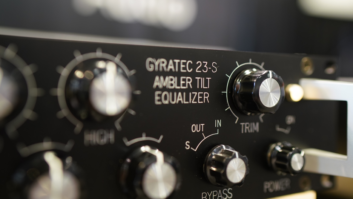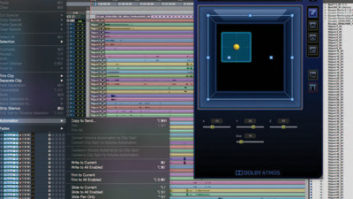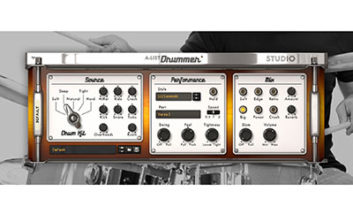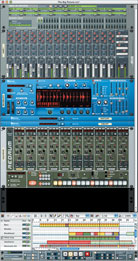
Although Reason is designed for speed, its versatility can at first be daunting. With all that virtual gear at your fingertips, finding your way around, choosing the right modules and following the signal path are not always no-brainers. Here are some tips to help you get the pedal all the way to the metal.
ERGONOMICS 101
Reason packs a lot of information into its virtual rack, but you don’t need to see everything at all times. You’ve undoubtedly discovered that clicking the little triangle at the upper-left corner of any module collapses it to a small half-inch panel, but you may not have noticed that Option-clicking (Alt-clicking on the PC) collapses all panels. One panel that you can almost always leave collapsed is the Hardware Interface panel at the top.
When you’re not using the Sequencer, you can size it by dragging its top border with the mouse, but there’s also a key command for toggling its display on and off (Command-1 on the Mac, Control-1 on the PC). You can toggle its size between normal and full-rack with Command-2 (Control-2).

Other handy key commands include Command-L to suppress the cables in the back-of-the-rack view (press Tab to get there); Command-B to open the file browser for any selected module that can import patches or samples; and Shift-Tab to switch between Arrange and Edit views in the Sequencer.
MIDI REMOTE CONTROL
You can control virtually any module knob, slider or switch with MIDI controllers. (You can also do this with your computer keyboard, but you’re limited to toggling between the minimum and maximum values of each parameter.) Each panel element that can be remote-controlled has a selection on its Context menu (right-click on the PC, Control-click on the Mac), which opens up a dialog box where you can assign a MIDI controller.
MIDI remote control can be turned on and off inside the Options menu, and it can be cleared there so that you can start over. It’s important to realize that the MIDI port used for MIDI remote control is assigned separately in Reason’s MIDI Advanced Preferences. The MIDI port used for sequencer input and Reason’s fixed MIDI remote assignments is set in the MIDI Preferences page. If the same port is used for both, then conflicts can occur. Obviously, the best solution is to use different ports, but if you have a one-port setup, you can still make your own assignments by either avoiding the fixed-assignment controllers or using a different MIDI channel.
MY FAVORITE REASON
Because three of Reason’s four sound modules are sample-based, you obviously have a lot of flexibility in how you use samples. For standard sampled instruments, NN-19 is the logical choice. Dr.Rex plays only Rex2 format files, but if you have ReCycle 2, you can create your own Rex2 files from any sample material. You can also use ReCycle to save individual Rex file slices and a matching MIDI sequence for use in the other samplers.
One of my favorite uses of the ReDrum drum sampler, and its built-in pattern sequencer, is as a remix tool. Loading loops, hits and effects into its 10 pads gives you three sample-processing styles (corresponding to the three different types of pads), two effects sends per pad, and real-time keyboard muting and soloing. (When 10 pads aren’t enough, remember you’re not limited to a single ReDrum module.)
With loops, you need to ensure that their tempos match the current project tempo (another job for ReCycle), and you should set the pad to Gate mode with its length set to 100 to have each trigger from the pattern sequencer play the loop exactly once. Typically, low-resolution settings for the pattern sequencer are most effective. For example, 64 steps at half-note resolution give you 32 bar patterns to play with.
CV AND GATE PATCHING
Most Reason modules have “back panel” inputs for modulating and gating various parameters. Many also provide modulation outputs. A little judicious re-wiring can provide a lot of additional sync and modulation possibilities. As just one example, you can use the gate output of a Dr.Rex module to trigger the envelope of an ECF-42 envelope-controlled filter that is processing a pad sound, thereby applying the Rex file rhythm to the pad.
The Matrix Pattern Sequencer module makes an excellent modulation source. In Curve mode, each sequencer step becomes a control value (rather than a gated note). That allows you to create and store 32-step control contours for controlling parameters like filter cut-off and resonance, oscillator phase, pan position, delay time, feedback, etc. Keep in mind that on the back panel, you can choose between Unipolar and Bipolar modes, depending on which best suits the parameter you’re controlling.
STAY TUNED
Propellerhead’s Website (www.propellerheads.se) contains an active user bulletin board, a growing supply of commercial as well as free Refills, many links to other Reason-related sites, and news on the release of Reason 2.0, which may be available by the time you read this. There is a new granular/wavetable synth as well as a new full-featured sampler with an orchestral sample library, and the sequencer has been enhanced and freed from the rack.
Len Sasso can be contacted through his Website at
www.swiftkick.com.
